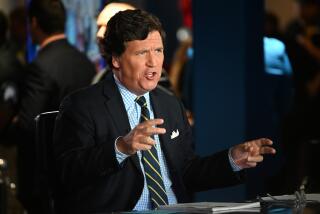Satellite, Cable at Last : For Europe, More to Touch on That Dial
- Share via
LONDON — For homesick Italians, the television set at the bar of London’s fashionable San Lorenzo restaurant is a tonic. Professional soccer matches and other favorites come through live on Radio Audizione Italia (RAI), the main Italian network.
In deference to tennis-loving Britons, the restaurant’s set sometimes is switched to West Germany’s SAT 1 network, known for its saturation coverage of German stars Boris Becker and Steffi Graf.
And when big news breaks, Ted Turner’s Cable News Network from the United States invariably dominates the screen.
“We get about 26 channels now,” boasts Lorenzo Berni, the restaurant’s owner. “It’s nice to have.”
Fast-Unfolding Revolution
Thanks to a satellite dish perched atop the building, Berni can offer patrons a taste of what many see as one of the most significant social developments of post-World War II Western Europe: a fast-unfolding television revolution.
From Sicily to northern Scotland, from Lisbon to Stockholm, European television viewers are entering a new age in which a cacophony of commercial offerings is challenging traditional state-subsidized network monopolies for their attention.
In addition to a growing number of new land-based commercial channels, more than 50 satellite and cable channels will be on the air across Western Europe by the end of this year. That number could double by the early 1990s, industry sources believe.
With the availability of smaller, cheaper satellite dishes and the expansion of cable networks in several countries, transmissions can now reach mass audiences.
While such a variety of choice is considered a birthright for American viewers, it’s no less than a revolution in Western Europe, where as recently as 1964, France had only one channel, and as recently as the early 1980s, German and British viewers had only three choices each. Five years ago, satellite television hardly existed here.
Now Europeans have both their own country’s channels and often their neighbors’ too.
The average household in Brussels receives 19 channels, including at least one from Luxembourg, France, the Netherlands, West Germany, Italy and Britain. In Bonn, cabled homes now get 21 channels, including transmissions from three neighboring countries.
The change has important implications for a continent searching for a greater sense of a common political and economic identity.
“It’s another binding element,” said Paul Taylor, a specialist on European integration at the London School of Economics. “It’s part of a slow process of shifting attitudes toward support for doing more together.”
Bowing to the inevitable, European governments are gradually dropping once-stringent barriers that, for example, still make it technically illegal for a viewer in France to receive a Belgian French-language channel.
A European Community directive entitled “Television Without Frontiers” is expected to be incorporated into the legal framework of the community’s 12 member countries by 1992, with even reluctant governments forced by events to comply.
“The advent of direct satellite broadcasting will resolve the matter once and for all,” noted Mario Maggiore, an architect of the community’s directive. “You can’t stop a program coming down. And once that happens, the frontiers have gone.”
Last November, the 22-nation Council of Europe also agreed on a draft convention that, for the first time, will subject programming throughout Western Europe to common standards in such areas as TV violence, pornography and methods of advertising.
Despite these developments, no one is predicting an immediate jump to pan-European viewing. Indeed, initial efforts at beaming the same program simultaneously to several countries have flopped.
One attempt to transmit English-language sitcoms throughout northern Europe, based on the premise that 80% of the target population has some knowledge of English, was watched by German viewers roughly long enough to realize they were on the wrong program.
“Humor doesn’t travel well and its even worse if it’s not your own language,” notes Helmut Markwort, editor of the West German television magazine Gong.
Television industry executives still talk of international programming, but in a more sophisticated way.
The satellite sports channel, Screensport, transmits the same picture across Europe, but accompanies it with French or English audio options. Spanish is scheduled to be added shortly.
Other satellite television companies plan similar multilingual ventures, initially with tightly focused sports, arts or all-news channels. Eventually, general entertainment programs with language dubbing will have a pan-European role, many predict.
“We’ll eventually see the same picture (for mainstream programs across Europe); it’s inevitable,” said Philip Haines, a television service development executive for Eutelsat, the Paris-based organization that plans to have four new satellites in orbit by the end of 1990. “It will just take a while.”
Advertising Problems
TV advertising executives have also discovered that the dream of reaching Western Europe’s 340 million consumers with a single message is, at best, premature. In most instances, cultural differences remain too great.
Maurice Levy, chairman of the French advertising agency Publicis, noted in a recent speech, for example, that Germans produce long-winded commercials packed with technical information, while the messages in British ads “are so remarkably succinct that they are just about incomprehensible to . . . continental Europeans.”
The timing of a commercial is also so culturally sensitive that the issue became a major stumbling block in recent efforts to draft a common code of standards.
Germans, accustomed to having their commercials in a few extended strings between programs before 8 p.m., strenuously opposed mid-program ad breaks, long a fact of life in Britain, where they are judged as essential for the survival of commercially funded television.
When commercial television began in France, French film makers initially expressed such outrage that their works were being interrupted by ads that the president of the French Academy of Cinema Arts and Techniques, Robert Enrico, protested what he called “mutilation of our films”--but to no avail.
Apparently bowing to the inevitable, the noted film maker Jean-Luc Godard recently requested permission to personally edit commercials into the televised version of his film “Breathless.” Council of Europe representatives eventually agreed a compromise formula permitting two commercial breaks in films under 110 minutes and a third if it exceeds this limit.
Europe’s television revolution also signals the end of an era when political leaders could manage the air waves, as French President Charles de Gaulle once did by ordering a blackout of 1968 student riots in Paris. British Prime Minister Margaret Thatcher’s restrictions on her own country’s network television will be far harder to apply to satellite transmissions originating elsewhere.
The gray bureaucrats who for decades shaped so much of the Old World’s television menu have also been eclipsed, overwhelmed by a stampede of media moguls and flashy entrepreneurs fighting for a slice of the action.
Some of the battles have already rattled the teacups in staid European parlors.
In Britain, media baron Rupert Murdoch’s mass circulation Sun newspaper has busily promoted his satellite venture with contests and eye-catching gimmicks such as the full-page photo of a prospective TV quiz show hostess, wearing little more than a bright smile.
There are also some ironic twists.
Murdoch’s Sun last year drove a popular British TV host off the air with allegations of sexual misconduct. But he was picked up by Sky Television as a premier newscaster well in time for the network’s launching last Sunday of four channels.
The growth of commercial television has added to the already considerable power of media figures.
In addition to Murdoch, other influential media figures now in commercial television including Robert Hersant, who controls nearly 30% of the French press, West German publisher Axel Springer and Silvio Berlusconi, an Italian who added a stake in a French network to his already considerable media holdings in Italy.
European Community officials, worried about excessive concentrations of power, have already conducted two studies of cross-market media holdings, but no immediate action is planned, they said.
In Italy, where deregulation has gone further than anywhere in Europe, Berlusconi is the most prominent figure in an era that has witnessed the arrival of several commercial networks and hundreds of local channels.
But offerings such as the popular amateur striptease game show Colpo Grosso (Big Shot)--a kind of “Family Fortune” without clothes--have been attacked by critics elsewhere in Europe as the type of mindless mediocrity that deregulation could bring.
“Deregulation means fragmented audiences and lower ad revenues,” said Gerry Buckland, corporate relations director of TVS Entertainment, part of Britain’s existing commercial network expecting a tough battle for revenues from new satellite competitors. “All stations will have to go down market to win the audiences.”
To stress the point, TVS last year launched an ad campaign showing a partially clad signora in mid-routine with the question: Do you really want it here?
“The point is that satellite television is deregulated and won’t be subject to government regulations,” said Buckland. “They’ll scrape the barrel to get viewers and ads.”
Others, however, see quality programming as the key to success in a crowded market.
Britain’s BSB has already paid an estimated $700 million for the rights to more than 1,000 Hollywood movies, including such hits as “Fatal Attraction,” “Cry Freedom” and “Top Gun.”
And as fledgling channels scramble to fill the thousands of hours of program time, Western Europe has suddenly become a major growth market for the U.S. entertainment industry.
But the economics of satellite television could become the most effective regulator. Here at least, money is likely to determine who survives.
Programming Commitments
Murdoch, with six satellite channels planned, has already spent over $180 million in start-up and first year operating costs, according to knowledgeable sources, while BSB will have spent $1.1 billion placing its own four-channel satellite in orbit in addition to huge sums on programming commitments before it begins its first transmission later this year.
Patrick Critten, chairman of the London-based communications and information research agency CIT Research Ltd., asserted that all 36 satellite television channels now operating in Europe are losing money and the long-term prospects are bleak for all but a handful of those now breaking into the market.
“I’m amazed that so many people, so shrewd in other areas of business, seem to abandon all powers of reason when the word satellite is mentioned,” he said in a recent interview. “The days are gone when there are just one or two channels, but there’s a limit to what can survive commercially.”
But some question whether Europe is ready for American-style choice of programming.
“Our studies throughout the 1980s have shown that only one in three (consumers) want more channels,” said Critten. “But when you ask if they are willing to pay, then the figure is less than half that.
“There’s a huge difference between the U.S. and European traditions in this area,” he added. “American television is served up to entertain and amuse with a minimum of concentration. Europeans watch much less, but take it more seriously.”
As the Guardian newspaper asked rhetorically:
“Can you bear the thought of flicking through all those channels?”
Times researcher Christine Courtney contributed to this article.
More to Read
The biggest entertainment stories
Get our big stories about Hollywood, film, television, music, arts, culture and more right in your inbox as soon as they publish.
You may occasionally receive promotional content from the Los Angeles Times.










